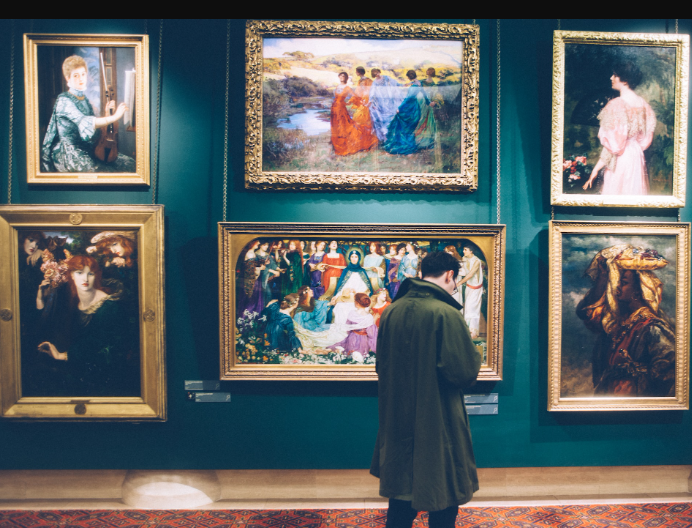The rise of online platforms has radically altered the art world’s purchasing practices. While traditional galleries have long been the primary venues for discovering and purchasing art, internet art marketplaces are reshaping the art-buying process. When the benefits of buying art online are compared to those of traditional galleries, it becomes clear why the digital approach is gaining appeal among collectors and enthusiasts. Here’s a closer look at how internet art purchases outperform traditional gallery visits.
Convenience and Accessibility
One of the most major benefits of purchasing art online is convenience. Online galleries are open 24 hours a day, seven days a week, allowing art fans to peruse and purchase artworks whenever it is convenient for them. This flexibility eliminates the need to plan visits around gallery hours, which can be inconvenient for people with hectic schedules or limited access to local galleries. Traditional galleries, on the other hand, have predetermined hours of operation that may not always correspond to the availability of potential purchasers.
Online platforms also allow customers to shop from anywhere in the world. Whether you’re at home, at work, or on vacation, you may discover and purchase art without regard for geography. Traditional galleries, on the other hand, are constrained by their physical location, which may make them inaccessible to all possible purchasers, particularly those living in remote places or other nations.
Extensive Selection and Diversity
Online art marketplaces provide a diverse range of artworks from various artists, styles, and periods, frequently outnumbering those available in real galleries. Platforms such as LANZART give customers access to a global pool of artists, allowing them to discover unique and diverse pieces that may not be available locally. From graffiti art culture to much more, visit LANZART to get your hands on the best art. This diverse range enables consumers to discover work that actually resonates with their likes and preferences, rather than being bound by a traditional gallery’s limited inventory.
Traditional galleries, while having curated collections, tend to have a smaller range due to physical space limits and a focus on specific artists or topics. This can occasionally limit the variety of possibilities available to collectors, especially those looking for anything other than the gallery’s current offerings.
Detailed information and transparency
Online art platforms frequently give extensive information about each artwork, such as high-resolution photographs, lengthy descriptions, artist biographies, and pricing. This transparency enables buyers to make informed decisions and grasp the context and value of the artwork. Buyers may explore artworks in more detail before purchasing thanks to features like zoomable pictures and virtual tours.
While traditional galleries allow you to see the artwork up close, information may be limited or inaccessible. The gallery personnel can provide information, although it may not be as extensive as what is available online. Furthermore, internet platforms frequently feature user evaluations and ratings, providing further information about the quality and contentment of prior consumers.
Easy Comparison and Research
Shopping for art online allows for quick comparisons of various items and artists. Buyers may easily compare artworks across many platforms, compare costs, and determine the suitability of various pieces for their location. Online tools and filters help to streamline the process, making it easier to find exactly what you’re looking for.
Traditional gallery visits may need repeated excursions to various places to assess possibilities, which can be time-consuming and inconvenient. Online art platforms bring together a diverse range of options in one place, allowing for more efficient study and comparison.
Streamlined Purchase Process
The purchasing process on online art sites is usually simple and effective. Buyers can complete deals with a few clicks, frequently using safe payment options and obtaining immediate order confirmations. Many online galleries also provide flexible payment options, such as instalment plans, making purchasing higher-priced artworks more manageable.
In traditional galleries, purchasing art may entail additional processes such as negotiating costs, arranging for delivery, and managing paperwork. These operations are simplified by online platforms, which often offer integrated payment, delivery, and framing solutions.
Enhanced Discoverability and Artistic Exposure
Online art platforms provide awareness for artists, particularly emerging or lesser-known talents who may not have representation in traditional galleries. This improved discoverability benefits both artists and customers by creating opportunities for fresh and diverse artistic expressions that might otherwise go unrecognized.
Traditional galleries frequently focus on established artists or those with established reputations, limiting opportunities for young talent. In contrast, online platforms level the playing field, allowing artists from all over the world to present their work and reach a larger audience.
Conclusion
Buying art online has several advantages over traditional galleries, including unrivalled convenience, a larger selection of artworks, detailed information, and a quick purchasing process. While conventional galleries offer valuable in-person experiences and local curation, online platforms like as LANZART are transforming the art-buying process by making it more accessible, diverse, and user-friendly. Get the best art including magnet art only at LANZART. As the digital art market expands, purchasers can reap the benefits of both worlds by smoothly combining online discoveries with traditional appreciation.
